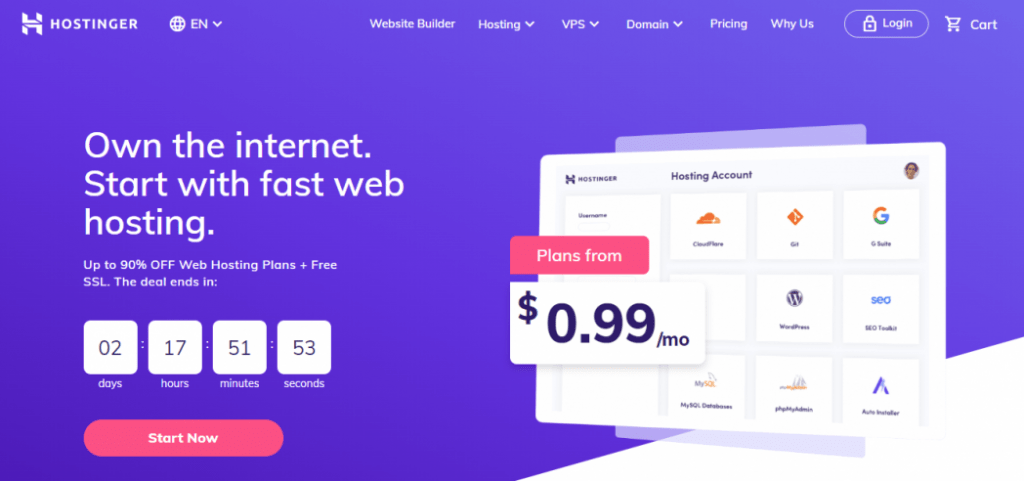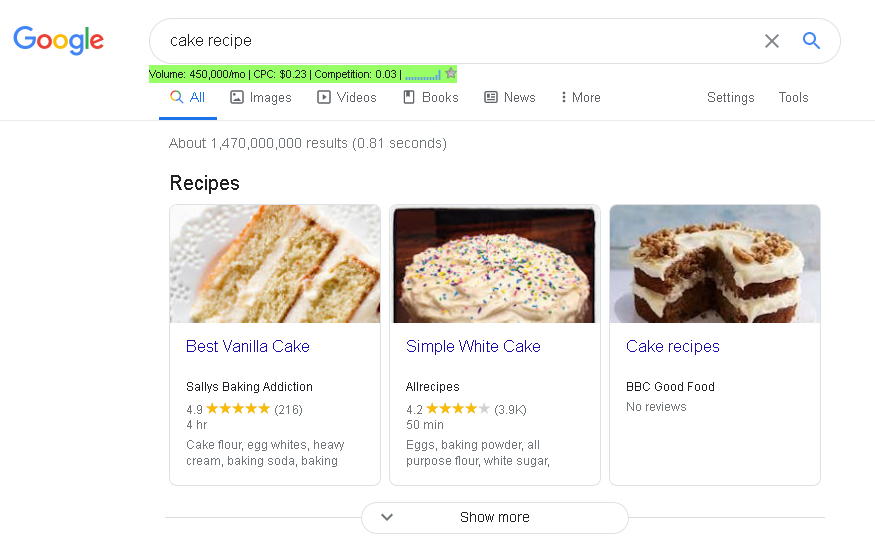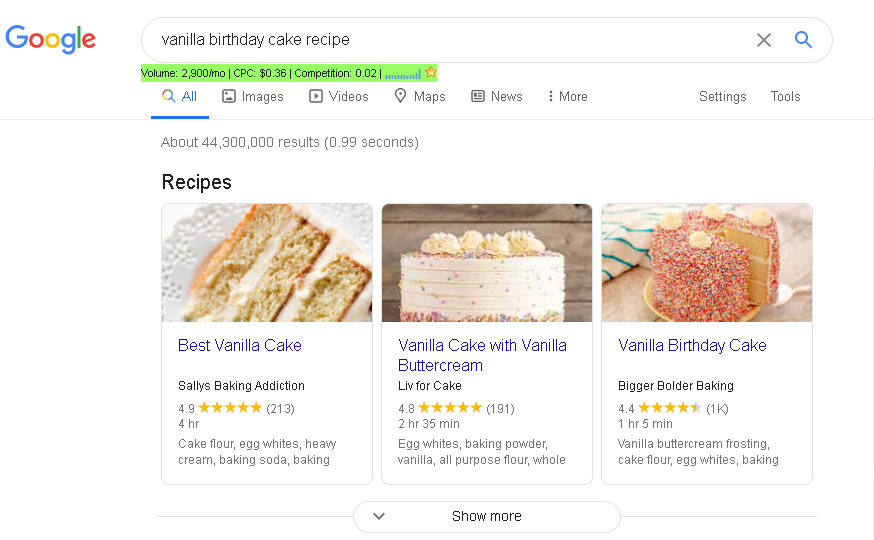
So, you want to start a food blog and make it big in the foodie blogosphere? Well, read our detailed guide below if you want to become the next top food blogging guru 😉 or at least make a nice side income from your passion for food and cooking.
There’s nothing better than making a successful business out of what you love doing in your spare time. Like cooking and taking photos (and tasting your delightful creations in the meantime ;-)).
Combine your passion for cooking with starting your own food blog, where you would share yummy recipes and cooking tips and you’ll have the ultimate foodie dream come true.
If you had this thought in mind for some time and are wondering whether you should start blogging about your favorite food, stop wasting time and get your food blog up and running with the in depth guide below.
Advantages of having a food blog in 2020
There are many good reasons to start a food blog now. But below we will highlight the main and most important ones.
Why you should start blogging about food, recipes and healthy, clean eating? Well, because this niche is evergreen and won’t become obsolete unless we start feeding on sun light (which won’t happen soon).
We need food every day to function properly, feel well and healthy. So, what better topic to choose other than food and cooking. It’s something we do every day throughout our entire life and it won’t come out of fashion anytime soon.
Another reason to take action now and create your little cute food blog is that the food industry is on the rise. In 2020, food and beverage industry will be worth about $225 billion and worldwide food industry is estimated to reach revenue of a whopping $7.5 trillion dollars in 2020 alone. And it will continue to grow.

Look, lets be honest. Most of us are drawn to the idea to have a food blog mainly because you could make a nice additional side income by just blogging about your passion or favorite hobby.
So, there’s plenty of cash flowing around. And if you manage to get even a grain of this you would make a fortune (if you make it big) or at least make a decent living by just blogging about food and your favorite dessert recipes, vegan meals or gluten free food, neat huh ;-).
How to start a Food Blog and Make Money
In the section below we’ll look closer at the various steps and optimizations you should do while you start and grow your food blog.
How to start your own successful and profitable food blog in 2020?
You may be wondering whether you should actually start a food blog right now. And, is it really worth it?
You bet it’s worth it. If you do it right, you can be the next Pinchofyum, Cookie and Kate or Pickledplum and make a small (or not that small) fortune out of your favorite cooking hobby. Who doesn’t want that?
With the current lock down crisis and uncertain times, when people stay mostly at home and many lose their jobs, having a safety net like a side source of income is a really smart thing to do.
Though, keep in mind your success won’t come overnight. It will take a few years before you start making any substantial income from your food blog. Take it as a long term investment and commitment. And from one point onward it becomes a real passive income source and an extremely valuable asset.
Now, before starting your own food blog you have a few options:
1. Do it yourself (the hard and less desirable route, unless you love writing, taking photos, cooking and tinkering with multiple techie stuff or fixing issues on your blog)
2. Hire a professional to do the job for you ( the most preferred, but costly option which not many aspiring bloggers can afford to use)
3. Outsource the hard work to freelancers or VA (virtual assistants) and keep the blog management part for yourself. This is perfect option if you want a professional to do the hard work for you, but still keep the control over your blog. You will just review their work and if you approve it you just hit publish and you are all set. It’s like being a big boss in a company. Other people will do the job you need and you just manage things around. That way you have more free time for your family and other things like working on a side project, enjoying your hobby or just have a nice vacation.
Whichever option you choose, there are some basic principles you need to get yourself familiar with in order to start a food blog. Even if you don’t grasp these principles from the beginning you will surely get a hold of how things work in terms of SEO, link building, marketing, outreach and blog management.
It’s not that hard as it may look, really. You just need to stick to it and maintain persistence in following your passion and eventually your dream, while blogging about your cooking or any other passion you have.

What you will need to start a food blog
1. Choose a domain name and reliable hosting
If you are struggling to come up with a good domain name for your food blog, you can find a domain name generator like this one helpful when searching for your new fancy domain.
You can then search for the availability of the domain using for example “Namesilo” company to search for it from here.
When deciding on your domain name make sure it’s short, memorable and reflects your blog topic or at least gives enough hints to users when they first see your URL in search, what your site is about. For a more in dept guide on how to pick a great domain go here .
Then when you have secured your pretty domain name, you should pick the right hosting service. The “right” means that your hosting should have responsive support which is always available to help you, reliable servers with higher uptime guarantee and which will not restrict your site while it grows i.e. have enough CPU and server resources to allow your blog to function without hiccups and unexpected interruption.
2. Use a blog software or CMS, preferably WordPress as it’s the most widely used blogging platform and it’s extremely easy to set up. Don’t confuse WordPress.org with WordPress.com though, as WordPress.com is a blogging platform( with free and paid plans) similar to blogger.com. While wordpress.org is a blogging software which you can download for free and install it on your hosting service provider.
There are also CMS tools like Drupal and Joomla, but they are less preferable as blogging solutions nowadays. Most bloggers and site owners prefer to use WordPress.
3. Create engaging, helpful content with pretty and share worthy, high quality photos
A picture is worth a thousand words they say. And it really can be worth many thousands of dollars if you manage to use them properly and take good use of them by sharing them on social platforms and mainly on Pinterest. Images, if SEO optimized with anchor text, captions and descriptions will also drive additional traffic from Google image search.
To start a food blog, along with great content, you will need to offer your visitors equally good, high quality photos of your recipes that will entice people visiting your blog to share them with their friends and family on social platforms.
For an in dept guide on how to make the best photos and tips on food photography check this article from cookieandkate.com and this helpful guide from Sally’s baking addiction.
That’s it. This is the short version of the main steps you need to follow when you create your recipe blog.
But hold your horses, of course there is much more work involved in setting up your blog. If it was that easy every one and their dog would be blogging around and cranking out 6 figure income, but this isn’t how it works.
So, read below our in debt guide on how to make your new blog a successful and profitable journey.
How to create your food blog
There are a few main steps to follow when you are creating your first food or recipe blog:
- Choose a reliable hosting company
There are many hosting providers out there and many are pretty decent options. But our favorite hosting provider is Hostinger . They make it incredibly easy and affordable to select and purchase domain names as well as sign up for their shared web hosting packages.
From a small company, managing domain names, Hostinger has for more than a decade diversified and grown by gradually moving to web hosting and offering full spectrum of site building tools.
Hostinger – Founded in 2004 in Lithuania, Hostinger offers web hosting services with shared plans, VPS or Cloud, a free website builder and an easy-to-Use custom control panel. You can also install WordPress with one click and cloud hosting plans are provided with Cloudflare CDN. Their Global Cloud offering runs on the Google Cloud infrastructure and is offered at quite attractive rates.
Over 15 years of existence, Hostinger has evolved into a company offering top quality shared, Cloud and VPS hosting services. Today, it has 7 data centers and several hundred employees worldwide, but the price of shared hosting still remains at the bare minimum, at less than $1 per month.
Although known for its domains, messaging and shared hosting services, Hostinger also offers options for virtual and dedicated servers. They make the upgrade process as transparent as possible, so you shouldn’t hesitate to upgrade your package as your site’s needs grow.
As the world’s first domain name registry, Hostinger offers very attractive prices on domain names and many promotional offers are regularly launched on the web. Quickly select and register a custom domain name, then sign up for one of their hosting packages to launch your new site in a blink of an eye!
If you sign up for one of their annual hosting plans, Hostinger will include your chosen domain name at no additional cost (for plan beginning at 2.89$/mo)
Depending on the hosting plan you have chosen, Hostinger offers an excellent set of tools for webmasters too. You will discover solutions for blogs, e-commerce sites, forums…you name it. You will only have to select the site building tools you need.
So, you are in pretty good hands with Hostinger and by having your site hosted at a stable host like them you can focus on just blogging about your favorite recipes and not worry that your site will suddenly go offline. Hostinger offers 99.95% uptime which is pretty good and is a standard among hosting providers nowadays.
It’s preferable to use hosting companies with Cpanel (your hosting dashboard or control panel where you can manage all your hosting settings and features) and you will likely prefer that option too. It’s a standard these days among hosting companies and only a few of the big ones have their own custom control dashboards.
Hostinger also offers a very wide range of hosting options. For less than US$1 per month. they also offer a 30-day Money-Back guarantee.
In addition, Hostinger strongest point is its 24-hour technical support (very important if you have any problem with your site) and they are available via phone, email or online chat, with a response time of less than 2 minutes! For novice webmasters, a dedicated support forum is available to help them with the most common issues.
Hostinger, which has more than 29 million users, already offers pretty much all you need to start a food blog and host it securely and reliably (read uptime and performance). But there are a few other hosting providers that are worth to check out if you have different needs.
Siteground a WordPress optimized hosting
SiteGround Hosting is an independent web hosting company founded in 2004. They are based in Bulgaria as well as in Madrid, but serve websites around the world with data centers on all major continents.
SiteGround is positioned as a company offering high quality and “well designed” hosting solutions at relatively competitive prices. It is also one of the web hosts recommended by the WordPress Foundation!
They offer a range of hosting solutions ranging from shared Linux hosting (the affordable and versatile type used by most websites) to Managed Cloud, to dedicated server solutions for larger, high-growth websites.
Kinsta Hosting
Kinsta is a specialized and dedicated WordPress hosting company that was founded in 2013 by a developer who was looking for the best hosting service for its Websites. Not finding a decent service, he decided to work hard to create his own hosting service.
Kinsta is a Hungarian company that has positioned itself in the US market pretty much on the first place for hosting providers and now extends to the rest of the world by offering services in different languages such as French, Spanish, Italian and German.
Hosting services also worth considering
Veerotech – A very reliable medium size hosting with great reviews among hosting savvy users
Crocweb – a Canadian hosting with very fast servers
Mightweb a privately owned company with great service and support. You even get to talk with the owner if you need support and can even have a chat with him. Talk about personal customer service.
Cloud hosting
Cloud hosting is the next step if you need to upgrade while your site grows and needs more server resources. It’s a bit faster compared to your normal shared hosting, though many shared hosting companies offer pretty fast performance even on their shared plans now.
CDN services
If you want your site to load in an instant you may want to add a CDN service to your blog. Though, when your site is still new and if you picked a decent hosting, your speeds would be quite fast, really. Nowadays technologies allow even small hosting companies to offer high performance service.
You will need a CDN probably only when your site starts to outgrow its resources, which is a sure sign you are being successful and need to step up to a higher performing hosting service or have an upgrade in your package of your current hosting.
So, here are a few great CDN services to choose from.
SEO, Keyword Research and Marketing of your Food Blog
Unless you have a lot of spare money for hiring professionals to do all aspects of your blogging adventure, you will likely need to have at least a basic understanding about SEO (search engine optimization) and link building when you want to start a food blog.
If you want to have a better chance at ranking your articles in higher search positions you should first do a proper keyword research, before you write any blog posts. There is a lot that can be said about keyword research for receiving a better rankings and more traffic. In general, what you want to do is find a low competition, long tail keywords, which are relevant to your niche.
Doing so, will ensure you pick the low hanging fruits and not waste too much energy, time and resources in chasing the almost impossible to reach high positions for the shorter one or two word keywords.
You may think that the food and cooking niches is already over saturated and the sweet top spots in Google SERPs (Search Engine Results Pages) are taken. And you’ll be right, to some extent. This is because the big guys in food blogging started earlier than most of us and of course took those top positions. But these positions are mostly for short, one or two keywords.
But to tell you, there are enormous amounts of long tail keywords which are just waiting for you to take advantage and create engaging content on them when you want to start a food blog. Long tail keywords are generally low competition keywords which are far easier for new blogs to rank for.
Let’s look at a basic keyword research example.
Keyword 1: cake recipe – it has 450 000 monthly searches and 1,470,000,000 Google search results (pages or individual sites listed in the results)
Note:The keyword data you see highlighted in green is from a nifty browser add-on called Keywords everywhere. It’s used constantly when doing research on any topic.You can get it here.
Any new blog or website doesn’t really have a chance to outrank the top ranking behemoths like bbcgoodfood.com or allrecipes.com( though not impossible, but highly unlikely)
Now lets look at a second, longer keyword
Long tail keyword 2: vanilla birthday cake recipe – this keyword has 2900 monthly searches and about 44,300,000 search results (for more on why number of search results matter see below)
This one looks much better and more achievable, right? The top ranking food blogs in this example are still with higher authority, than a brand new blog, but they are way easier to outrank or at least rank on the first page close to their positions than the sites from the first keyword example above.
We can go further and take a longer keyword, which will be even easier for your new blog to rank and get to the first page.
Longer tail keyword 3: vanilla cake recipe without buttermilk – this long tail keyword has 1300 monthly searches and 11 900 000 results and if you target that keyword you obviously have much more chances to rank higher on the first page compared to a high competition term like cake recipe.
It’s important to try and rank your blog posts on the first page of Google (the higher the better of course), because very few people that search on any topic will click trough the second and even less to the third page of results as shown in this research.
Once you reach the first page even if you are on 9th or 10th position, the largest part of your work is done. Being on the first page gives you a better horizon and foundation for your keyword to rank even higher overtime if you have good backlinks and a great engaging content on your site.
We should look at both monthly searches and the number of search results, because it gives you a rough idea for how competitive and reachable a given keyword is and how much easier it is to rank for that keyword. Actually there is a way to calculate that easiness or reachability of a keyword and it’s called a “keyword golden ratio” as shown here.
Doing keyword research takes time and efforts, so you will need to use the right software in the process. There are many useful tools available today both free and paid ones. Below are listed some of the best tools you can find for keyword, domain research, checking backlinks and many other SEO or marketing tasks.
Free keyword/domain tools:
Ubersuggest– this is the trending keyword tool among marketers lately. Neil Patel bought it a few years ago and turned it into a full fledged SEO analysis and research solution. Oh, and its free. There is a paid package, but you can still do a lot of useful research with the free plan, really.
Keyword Surfer – a free Chrome extension similar to keywords everywhere, but with limited data for the keywords
Google Trends – useful for researching what topics are the most searched at any given time period
Keyword sheeter – despite its “unusual” name, it can give you quite a lot of useful keyword ideas based on the autocomplete data from Google and will do it for free.
Answer the Public – it will help you find any question based keywords related to your main topic of interest. Don’t get spooked by the guy staring at you while you enter your keywords…
Spyfu – this tool can be useful for keyword research even on it’s free version and will show you at least some basic insight about your SERP positions and competitors.
You can mostly concentrate on free tools and there are pretty decent free options available, but if you want more features and/or bells and whistles, here are some of the best well known and established paid keyword research tools.
Paid keyword tools:
- Semrush
- Ahrefs
- Kwfinger
- keywordtool.io
- Wordtracker
- Wordstream
- Spyfu
- Majestic
Basically Ahrefs and Semrush are the standard among serious marketers and SEO experts these days. Not saying the other options are less valuable, but they offer the best data in an all in one platforms. All the paid research tools have free trials, so, make sure to check them out if you are doing extensive SEO work and are serious about keyword, domain or niche research.
How to monetize a food blog
- Display Ads (Google AdSense, Ezoic, Mediavine, Adthrive).
- Affiliate Marketing.
- Start Building your Email List.
- Sell or promote eBooks with your recipes.
- Email Advertising: This is great way to utilize your email list.
- Monetize your Youtube channel videos
- Use video ad networks
Once you have any substantial amount of traffic coming to your blog ( at least a few thousand visitors per day), you can easily find a way to monetize that traffic. From then on and as your traffic grows further, it will be only a matter of maximizing your earnings and diversifying your revenue streams.
For example you can use several or all of the monetization methods listed above and see what earns you the most and which method works for you. Then keep the best converting ones and reap(enjoy) the benefits.
Things to do to get organic traffic
Leverage best SEO tactics. There are many ways to approach search engine optimization, but in general what you want to make sure is having a high quality, helpful and engaging content that people will love sharing on their social profiles. Acquire backlinks from topically relevant high authority blogs and sites.
Interlink your blog posts and point keywords mentioned in your articles to relevant posts on the same topic.
Example: If you have a recipe blog post about birthday cake, you would mention that you have a chocolate cake recipe you made last week and will link to that post from your current post. This is how you do on site SEO i.e you optimize your site from within your blog posts by interlinking them with other relevant posts you have on your blog.
That way you tell Google you have other related content which should be considered by the search engine and you will pass “link juice” to these other posts too.
Use Instagram to Drive Traffic. We all know what Instagram is and using their platform to post your images(and videos) will be a great way to spread the word about your posts.
Create a Youtube channel and post Videos for your recipes or cooking lessons.
This also applies if you have a site in almost any other niche. YouTube is the second biggest search engine after Google, so it will be a big mistake to not take good use of this traffic source.
Pin regularly on Pinterest
Pinterest is currently the biggest image search engine (aside from Google images) and social network combined into a single platform. It receives more than 360 million active monthly users for the first quarter of 2020. So, neglecting this huge potential traffic source of highly engaged people searching mainly for food and recipe images will be a poor decision, which could negatively affect your food blog’s future growth.
Make sure you follow some basic Pinterest SEO rules and tips when pinning to that platform in order to have the best results in terms of traffic and engagement on your pins.
And of course post updates about your delicious recipes on Facebook and Twitter to get an additional social following. Just make sure you post engaging, share worthy photos and helpful information.
There you go, if you reached that far reading our long guide you should now have at least a basic understanding about the main steps you should follow in order to have a successful and profitable food blog.
If you have any questions or comments, leave it in the comments below.




